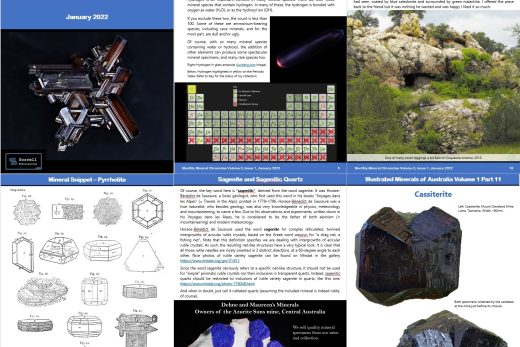Featured image: Calcite, Avebury Mine
The full text and photos of the minerals from Avebury can be found in Issue 2 of the Australian and New Zealand Mineral Collector magazine.
The Avebury area is located approximately 8 km west of Zeehan in western Tasmania, where over the last few years, exploration has identified a number of potential nickel orebodies. Mining commenced a couple of years ago but now the mine is on a care and maintenance basis.
Gangue minerals include serpentine minerals (mostly lizardite and antigorite), talc, chlorite (clinochlore), olivine (forsterite?), pyroxenes (diopside?), prehnite, amphiboles (tremolite, actinolite and hastingsite?), axinite (ferroaxinite?), epidote-clinozoisite, sphene, tourmaline (dravite?), quartz, feldspars (plagioclase and orthoclase), micas (phlogopite and muscovite?), fluorapophyllite, fluorapatite, calcite, dolomite, rutile and spinels (magnetite and chromite-magnesiochromite)
Veins formed during or following this thermal and metasomatic event contain prehnite, axinite, calcite, dolomite, fluorapophyllite, pyrite and other minerals, some in very attractive specimens where vughs occur.
The sulphide ore minerals occur in both the serpentinites and amphibolitic rocks. Pentlandite is the most abundant sulphide, unlike most other nickel deposits, usually dominated by iron sulphides, and this makes the deposits metallurgically attractive. Other sulphides in the deposits include minor pyrite, pyrrhotite, chalcopyrite, millerite, mackinawite, sphalerite, a valleriite-haalpaite series mineral and minor arsenides also occur: nickeline, gersdorffite and maucherite, and also trace native bismuth (McKeown, 1998, Bottrill, unpub.). There is also trace cobalt in the ores, probably mostly within the nickel sulphides. Native copper is reported from analysis of rock chip samples at the Avebury South prospect.



